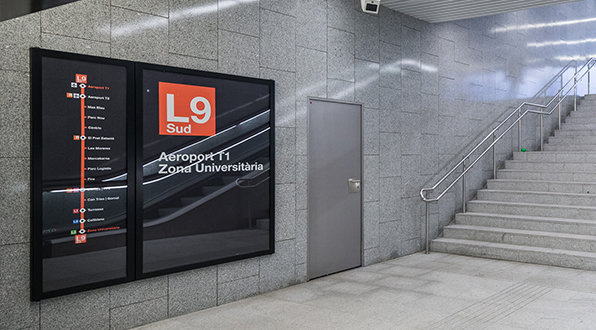L9 Sud
On 12 February 2016 a new stretch of metro line 9, from Zona Universitària to Barcelona-El Prat Airport, known as L9 Sud came into service. The stretch between Santa Coloma de Gramenet and La Sagrera is now known as L9 Nord.
L9 Sud goes through Barcelona, L’Hospitalet and El Prat de Llobregat. It links the Zona Universitària district with the airport's terminal 1 and serves areas that previously had no metro service. This new stretch adds 20 km (19.6 km) to the current network and 15 new stations, all of which are wheelchair accessible. The complete journey takes 32 minutes and trains run every 7 minutes on weekdays.
Stations on L9 Sud: Zona Universitària, Collblanc, Torrassa, Can Tries/Gornal, Europa/Fira, Fira, Parc Logístic, Mercabarna, Les Moreres, El Prat Estació, Cèntric, Parc Nou, Mas Blau, Aeroport T2 and Aeroport T1.
Camp Nou, La Ribera and Aeroport terminal de càrrega stations will come into service at a later date.
Special features
- Length of the stretch: the new stretch is a considerable extension of the line – 20 km – comparable to the length of line 1.
- More automated metro line: line 9/10 will have 31 km and 27 stations in operation. The metro network will cover a total of 122 km, 25% of which will be driverless.
- Metro to the airport: with the L9 Sud the metro runs all the way to the airport, a real achievement for Barcelona public transport. It also links parts of the metropolitan area that previously had no metro, particularly industrial areas and others of major economic and social activity. The line thus improves links within the metropolitan area.
- Infrastructure challenge: from Aeroport to Europa Fira the stations are conventional, like the rest on the Barcelona metro. From Can Tries/Gornal to Zona Universitària the stations will have the usual L9 format, with a well structure and a 12-metre diameter tunnel through which the trains run on two levels, with a separation between tracks.
- New service and information models: this extension brings with it new metro service and management models, along with new user information systems which are more active and dynamic.


















